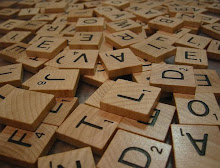SCRABBLE
Rules: Scoring
1.
Use a score pad or piece of paper to keep a
tally of each player's score, entering it after each turn. The score value of
each letter is indicated by a number at the bottom of the tile. The score value
of a blank is zero.
2.
The score for each turn is the sum of the letter
values in each word(s) formed or modified on that turn, plus the additional
points obtained from placing letters on Premium Squares.
3.
Premium Letter Squares: A light blue square
doubles the score of a letter placed on it; a dark blue square triples the
letter score.
4.
Premium Word Squares: The score for an entire
word is doubled when one of its letters is placed on a pink square: it is
tripled when one of its letters is placed on a red square. Include premiums for
double or triple letter values, if any, before doubling or tripling the word
score. If a word is formed that covers two premium word squares, the score is
doubled and then re-doubled (4 times the letter count), or tripled and then
re-tripled (9 times the letter count). NOTE: the center square is a pink
square, which doubles the score for the first word.
5.
Letter and word premiums count only on the turn
in which they are played. On later turns, letters already played on premium
squares count at face value.
6.
When a blank tile is played on a pink or red
square, the value of the word is doubled or tripled, even though the blank
itself has no score value.
7.
When two or more words are formed in the same
play, each is scored. The common letter is counted (with full premium value, if
any) for each word. (See Turns 3, 4 and 5 in the Scoring Examples section.)
8.
BINGO! If you play seven tiles on a turn, it's a
Bingo. You score a premium of 50 points after totaling your score for the turn.
9.
Unplayed Letters: When the game ends, each
player's score is reduced by the sum of his or her unplayed letters. In
addition, if a player has used all of his or her letters, the sum of the other
players' unplayed letters is added to that player's score.
10.
The player with the highest final score wins the
game. In case of a tie, the player with the highest score before adding or
deducting unplayed letters wins.
Scoring
Examples
In the following, the words added on five
successive turns are shown in bold type. The scores shown are the correct
scores if the letter R is placed on the center square. In Turn 1, count HORN:
in Turn 2, FARM; in Turn 3, PASTE and FARMS; in Turn 4, MOB, NOT and BE; in
Turn 5, BIT, PI and AT.






